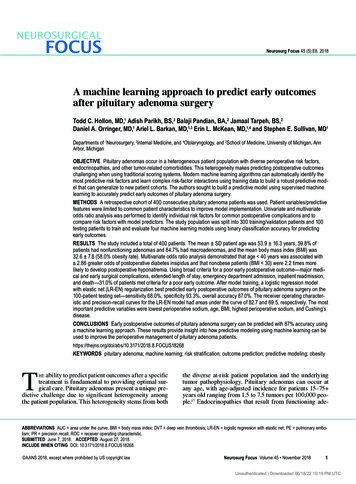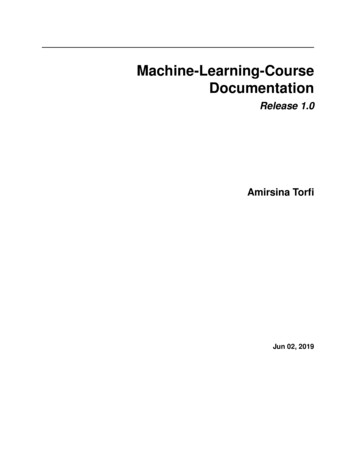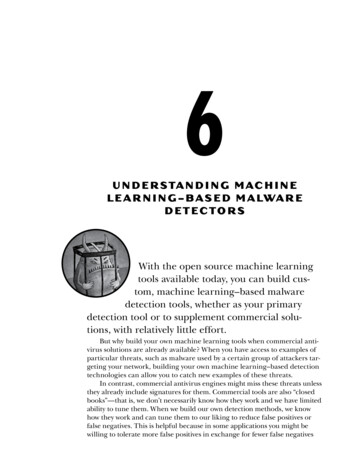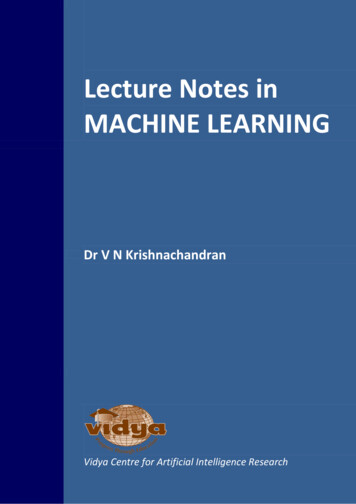
Transcription
NEUROSURGICALFOCUSNeurosurg Focus 45 (5):E8, 2018A machine learning approach to predict early outcomesafter pituitary adenoma surgeryTodd C. Hollon, MD,1 Adish Parikh, BS,2 Balaji Pandian, BA,2 Jamaal Tarpeh, BS,2Daniel A. Orringer, MD,1 Ariel L. Barkan, MD,1,3 Erin L. McKean, MD,1,4 and Stephen E. Sullivan, MD1Departments of 1Neurosurgery, 3Internal Medicine, and 4Otolaryngology, and 2School of Medicine, University of Michigan, AnnArbor, MichiganOBJECTIVE Pituitary adenomas occur in a heterogeneous patient population with diverse perioperative risk factors,endocrinopathies, and other tumor-related comorbidities. This heterogeneity makes predicting postoperative outcomeschallenging when using traditional scoring systems. Modern machine learning algorithms can automatically identify themost predictive risk factors and learn complex risk-factor interactions using training data to build a robust predictive model that can generalize to new patient cohorts. The authors sought to build a predictive model using supervised machinelearning to accurately predict early outcomes of pituitary adenoma surgery.METHODS A retrospective cohort of 400 consecutive pituitary adenoma patients was used. Patient variables/predictivefeatures were limited to common patient characteristics to improve model implementation. Univariate and multivariateodds ratio analysis was performed to identify individual risk factors for common postoperative complications and tocompare risk factors with model predictors. The study population was split into 300 training/validation patients and 100testing patients to train and evaluate four machine learning models using binary classification accuracy for predictingearly outcomes.RESULTS The study included a total of 400 patients. The mean SD patient age was 53.9 16.3 years, 59.8% ofpatients had nonfunctioning adenomas and 84.7% had macroadenomas, and the mean body mass index (BMI) was32.6 7.8 (58.0% obesity rate). Multivariate odds ratio analysis demonstrated that age 40 years was associated witha 2.86 greater odds of postoperative diabetes insipidus and that nonobese patients (BMI 30) were 2.2 times morelikely to develop postoperative hyponatremia. Using broad criteria for a poor early postoperative outcome—major medical and early surgical complications, extended length of stay, emergency department admission, inpatient readmission,and death—31.0% of patients met criteria for a poor early outcome. After model training, a logistic regression modelwith elastic net (LR-EN) regularization best predicted early postoperative outcomes of pituitary adenoma surgery on the100-patient testing set—sensitivity 68.0%, specificity 93.3%, overall accuracy 87.0%. The receiver operating characteristic and precision-recall curves for the LR-EN model had areas under the curve of 82.7 and 69.5, respectively. The mostimportant predictive variables were lowest perioperative sodium, age, BMI, highest perioperative sodium, and Cushing’sdisease.CONCLUSIONS Early postoperative outcomes of pituitary adenoma surgery can be predicted with 87% accuracy usinga machine learning approach. These results provide insight into how predictive modeling using machine learning can beused to improve the perioperative management of pituitary adenoma .FOCUS18268TKEYWORDS pituitary adenoma; machine learning; risk stratification; outcome prediction; predictive modeling; obesityhe ability to predict patient outcomes after a specifictreatment is fundamental to providing optimal surgical care. Pituitary adenomas present a unique predictive challenge due to significant heterogeneity amongthe patient population. This heterogeneity stems from boththe diverse at-risk patient population and the underlyingtumor pathophysiology. Pituitary adenomas can occur atany age, with age-adjusted incidence for patients 15–75 years old ranging from 1.5 to 7.5 tumors per 100,000 people.17 Endocrinopathies that result from functioning ade-ABBREVIATIONS AUC area under the curve; BMI body mass index; DVT deep vein thrombosis; LR-EN logistic regression with elastic net; PE pulmonary embolism; PR precision recall; ROC receiver operating characteristic.SUBMITTED June 7, 2018. ACCEPTED August 27, 2018.INCLUDE WHEN CITING DOI: 10.3171/2018.8.FOCUS18268. AANS 2018, except where prohibited by US copyright lawNeurosurg Focus Volume 45 November 20181Unauthenticated Downloaded 06/18/22 10:19 PM UTC
Hollon et al.nomas can produce severe preoperative comorbidity, suchas obesity, diabetes mellitus, and cardiomyopathies. Complication rates after transsphenoidal surgery for Cushing’sdisease range up to 42%.19 However, nonfunctioning adenomas are more likely to present in older patients, whomay have multiple chronic medical conditions that canincrease perioperative surgical risk.8 The clinical diversityof pituitary adenoma patients makes it challenging to usetraditional biostatistical techniques or scoring systems tostratify surgical risk or predict postoperative outcomesgiven that specific patient characteristics (e.g., tumor type,age, and body mass index [BMI]) are likely to vary in predictive importance across the entire patient population.Advances in applied predictive modeling using machine learning have provided a novel method for predicting outcomes in healthcare.5 Machine learning modelshave an advantage over other predictive methods becausemachine learning enables a predictive computer model toautomatically learn the best predictive features present intraining data. As opposed to the use of a human operatorto manually identify these features, which is time and labor intensive, machine learning models can automaticallyidentify the most robust predictive features and can potentially generalize this information to new patient cohorts.Previous studies have used these methods to predict outcomes of stereotactic radiosurgery for brain metastases15and arteriovenous malformations,16 stratify cardiovascularrisk,14 predict mortality/readmission/length of stay,1 andmake cancer prognoses.26To improve the perioperative management and riskstratification of pituitary adenoma patients, we aimed topredict early outcomes of pituitary adenoma surgery using a machine learning approach. By analyzing a largecohort of pituitary adenoma patients treated at a tertiarycare center, we sought to develop an accurate predictivemodel built via modern machine learning methods thatwill identify patients at high risk for poor early outcomesafter pituitary adenoma surgery.MethodsStudy DesignWe designed a retrospective analysis of 400 consecutive pituitary adenoma patients treated with surgical resection via an endoscopic endonasal approach by thesenior authors (E.L.M., S.E.S.). After IRB approval, twoindependent reviewers completed a systematic chart review using a standardized database template. In additionto formal chart review, the University of Michigan Electronic Medical Record Search Engine (UM-EMERSE)9was used to confirm patient details and/or any discrepancybetween reviewers.The study aims were to 1) perform exploratory dataanalysis of a large series of pituitary adenoma patientstreated at a high-volume medical center with an integratedneuroendocrine center and 2) develop and validate a supervised machine learning model that can predict early postoperative outcomes. We defined a poor early postoperativeoutcome using broad and inclusive criteria, which included the following: 1) major adverse medical event within 30days of surgery (including deep vein thrombosis [DVT]/2pulmonary embolism [PE], myocardial infarction, severearrhythmia, or stroke), 2) early surgical complication(CSF leak with or without symptomatic pneumocephalusor postoperative meningitis), 3) expected length of stay (2days for non-Cushing’s disease, 4 days for Cushing’s disease) exceeded by 2 days, or any of the following within30 days of surgery: 4) emergency department admission,5) inpatient admission, or 6) death. Extended length ofstay for nonmedical reasons (transportation, rehabilitationbed availability, social reasons, etc.) was not included as apoor outcome. Because these outcomes can be overlapping(e.g., extended hospital stay due to PE), patients who experienced any or all of these outcomes were assigned to thepoor outcome group using a binary classification. Sodiumdysregulation (diabetes insipidus or hyponatremia) itselfwas not considered a poor early postoperative outcome, asit can often be managed effectively in outpatients withoutcomplication (i.e., unrestricted free water intake for diabetes insipidus or fluid restriction for hyponatremia). Patientswith sodium dysregulation that resulted in unanticipatedpostoperative care, such as extended length of stay or readmission, were included as poor postoperative outcomes.Patient characteristics/model predictors were establishedprior to initiating chart review. To improve future modelimplementation, model predictors were chosen to includeonly standard clinical information common to all pituitary adenoma patients. Disease-specific characteristics(e.g., preoperative adrenocorticotropic hormone [ACTH]levels) and advanced radiographic features (e.g., Knospscore) were avoided to eliminate missing/not applicabledata values and data sparsity.Descriptive Statistics and Data ExplorationAll patient characteristics and outcomes were dividedinto continuous or nonordered categorical variables forstatistical analysis. In addition to the poor early postoperative outcomes defined above, risk factors for commonpostoperative complications after pituitary adenoma surgery were also explored. Using the full 400-patient dataset, pairwise odds ratio analysis was performed to explorerisk factors for diabetes insipidus, hyponatremia, transientcranial nerve palsy, cerebrospinal fluid leaks, symptomatic pneumocephalus, DVT/PE, and postoperative meningitis. For univariate analysis, continuous variables wereconverted to an indicator variable using binary encoding(e.g., age 40 years, BMI 30) to allow for odds ratiocalculation. Univariate statistical significance was calculated using Fisher exact testing and defined as p 0.05.Multivariate logistic regression was done for postoperative complications with multiple statistically significantpredictors to account for covariance among variables. TheR Environment for Statistical Computing (version 3.3.1;http://www.r-project.org) and Python-based SciPy library(version 0.19.1, https://www.scipy.org) were used for statistical analysis.Supervised Machine LearningFour supervised machine learning algorithms weretrained and tested as binary classifiers to predict earlypostoperative outcomes in pituitary adenoma patients:Neurosurg Focus Volume 45 November 2018Unauthenticated Downloaded 06/18/22 10:19 PM UTC
Hollon et al.naïve Bayes, logistic regression with elastic net (LR-EN)regularization (linearly combined L1 and L2 regularizationpenalties), support vector machines with linear kernel, andrandom forest. These methods were selected for algorithmdiversity (i.e., Bayesian model, generalized linear model,margin classifier, and decision trees). Twenty-six patientcharacteristics were used as predictive variables. Modelhyperparameters were selected using a grid search, and10-fold cross-validation was performed for each model.The training/cross-validation set and testing set were selected by random sampling without replacement fromthe full 400-patient study population using a 75%/25%(300/100 patient) split. To improve clinical relevance andallow patient risk to be recalculated in the perioperativesetting (“rolling” risk assessment), perioperative lowestand highest sodium levels were used as predictors. Datapreprocessing included rescaling continuous variables tobetween 0 and 1. Model training and performance wasevaluated using prediction accuracy: model accuracy (true positives true negatives)/(true positives false positives true negatives false negatives).To further evaluate the models, both receiver operating characteristic (ROC) and precision-recall (PR) curveswere generated, and area under the curve (AUC) was calculated. To determine the best-performing model, McNemar’s test was used to evaluate marginal homogeneity anddetermine statistically significant differences betweenmodel predictions. Variable importance for the best-performing model is reported to improve model interpretability and assessment of clinical relevance. The R “caret”package (http://caret.r-forge.r-project.org) was used formodel training, hyperparameter search, validation, andtesting. The R and Python code can be downloaded athttps:// github.com/toddhollon/pituitary ml.ResultsPatient Population and Early Postoperative OutcomesThe mean age of the study population was 53.9 16.3years, ranging from 13 to 91 years, and 54% were male.Caucasians made up 84% of patients and blacks 10%.Nonfunctioning pituitary tumors were the most common(59.8%) followed by growth hormone–secreting adenomas(22.8%) and ACTH-secreting adenomas (13.0%). Previoustreatment with transsphenoidal surgery or radiation therapy had been performed in 16.5% and 4.0% of patients, respectively. A listing of patient characteristic can be foundin Table 1. Differences in sex, tumor size, age, and BMIwith respect to tumor type are shown in Fig. 1.Sodium dysregulation was the most common complication after pituitary adenoma surgery (Table 2). Diabetesinsipidus and hyponatremia occurred in 14.8% and 14.3%of patients, respectively. Prevalence of cerebrospinal fluidleak was 7%, and 2% of patients developed symptomaticpneumocephalus. Acute DVT/PE was found in 1.5% ofpatients, and 1.3% developed postoperative meningitis.Extended length of stay occurred in 20.7% of non-Cushing’s disease patients and 30.8% of Cushing’s disease patients. Thirty-day emergency department admission andsubsequent inpatient readmission occurred in 17.0% and11.8% of patients, respectively. Thirty-day mortality rateTABLE 1. Preoperative patient characteristicsCharacteristicAge in yrsMaleRaceWhiteBlackOtherTumor typeNonfunctioningAcromegalyCushing’s diseaseProlactinomaTSHomaTumor sizeMacroadenomaBMI in kg/m2Previous TSPrevious skull base radiationPreoperative visual deficitDiabetes mellitus, type IIHeart disease*Pulmonary diseaseLiver diseaseRenal diseasePreop antiplatelet/anticoagulantValue53.9 16.3 (13–91)219 (54%)336 (84%)40 (10%)24 (6%)239 (59.8%)91 (22.8%)52 (13.0%)16 (4.0%)2 (0.5%)339 (84.7%)32.6 7.8 (19.4–69.7)66 (16.5%)17 (4%)179 (44.8%)91 (22.8%)34 (8.5%)26 (6.5%)17 (4.3%)7 (1.8%)115 (28.8%)TS transsphenoidal surgery; TSHoma thyroid-stimulating hormone–secreting tumor.Values are presented as mean SD (range) or number of patients (%).* Includes congestive heart failure, ischemic cardiomyopathy, history of myocardial infarction, arrhythmias.was 1% (4/400). Based on the study defined criteria, 31%(124/400) of patients had a poor early postoperative outcome, with the top four inclusion criteria being emergencydepartment admission, extended length of stay, inpatientreadmission, and CSF leak (Fig. 2, left). A single inclusionoutcome occurred in 13% (52/400) of patients, while 18%(72/400) had two or more (Fig. 2, right).Data Exploration and Odds Ratio AnalysisTo explore risk factors for specific complications afterpituitary adenoma surgery, we performed a pairwise univariate odds ratio analysis of patient characteristics andcomorbidities (Fig. 3). Diabetes insipidus was associatedwith age 40 years, Cushing’s disease, microadenomas,and no history of anticoagulation/antiplatelet use. Onmultivariate logistic regression, age was the only predictor that remained statistically significant, with patientsyounger than 40 years having 2.86 greater odds of postoperative diabetes insipidus (95% CI 1.52–5.27, p 0.001).Patients with microadenomas were 1.9 times more likelyto develop diabetes insipidus; however, this trend did notreach statistical significance on multivariate regression(OR 1.93, 95% CI 0.91–3.98, p 0.076). A relationshipNeurosurg Focus Volume 45 November 20183Unauthenticated Downloaded 06/18/22 10:19 PM UTC
Hollon et al.FIG. 1. Patient characteristics by pituitary adenoma diagnosis. A: Nonfunctioning adenomas (62.3%) and acromegaly (63.4%)were more common in male patients. Cushing’s disease was more common in female patients (80.7%). B: Macroadenomas weremore common in our study population (84.8%) and the majority were nonfunctioning adenomas (67.8%). Cushing’s disease hadalmost equal distribution between microadenomas (51.9%) and macroadenomas (48.1%). C: Mean age of patients with nonfunctioning adenomas was 58.9 14.4 years and was significantly greater than the age of patients with functioning adenomas (mean46.3 16.1 years, p 0.000). D: Prolactinoma patients had the greatest BMI (36.5 13.0), followed by Cushing’s disease patients(36.0 9.6) and acromegaly patients (32.4 7.0). TSHoma thyroid-stimulating hormone–secreting tumor.was identified between age and tumor size, with patientsolder than 40 years having a 2.02 (95% CI 1.08–3.69)greater odds of being diagnosed with a macroadenoma (p 0.021).Obesity was inversely correlated with postoperativehyponatremia on multivariate analysis (OR 0.46, 95% CI0.25–0.82, p 0.009), and a clinically significant trendtoward older patients being more likely to develop hyponatremia was observed (OR 2.48, 95% CI 1.03–7.00, p 0.058). History of skull base radiation was associatedwith postoperative symptomatic pneumocephalus (OR8.6, 95% CI 1.1–42.9, p 0.040), and recurrent pituitaryadenomas/previous resection was associated with postoperative meningitis (OR 7.7, 95% CI 1.1–67.0, p 0.03).Cushing’s disease (OR 12.2, 95% CI 2.2–92.3, p 0.006)and a history of congestive heart failure (OR 7.8, 95%CI 0.91–49.8, p 0.04) significantly increased the oddsof DVT/PE on both univariate and multivariate logisticregression. Multivariate analysis included preoperativeantiplatelet/anticoagulant use to account for perioperative cessation of medications. Of the 4 patients who diedwithin 30 days of surgery, 3 had Cushing’s disease (p 0.008). To further explore the relationships among age,BMI, and sodium dysregulation, the distribution of post4operative sodium values was plotted with respect to ageand BMI (Fig. 4).Predicting Early Postoperative Outcomes Using MachineLearningAfter training and cross-validation of the four machinelearning models, they were tested on an independent testing set of 100 patients. Performance data of each modelcan be found in Table 3. The LR-EN model achieved thehighest accuracy at 87.0% (95% CI 78.8–92.9; optimizedhyperparameters: alpha 0.05, lambda 0.005), followedby the random forest model (85.0%, 95% CI 76.5–91.4;optimized hyperparameter: mtry 7). A significant improvement in model sensitivity was noted for LR-EN andrandom forest over naïve Bayes classifier and support vector machines. A statistically significant difference in model prediction accuracy was found between LR-EN versussupport vector machines and naïve Bayes, but not randomforest. Areas under the ROC and PR curves are presentedin Table 3. The LR-EN model had the largest AUC-PR(69.5%) and second largest AUC-ROC (82.7%).ROC and PR curves for each model are presented inFig. 5A and B. To better understand the output predictionNeurosurg Focus Volume 45 November 2018Unauthenticated Downloaded 06/18/22 10:19 PM UTC
Hollon et al.TABLE 2. Summary of early postoperative complications andoutcomesComplication/OutcomeValueLowest postop sodium in mEq/LHighest postop sodium in mEq/LDiabetes insipidus*Diabetes insipidus requiring desmopressinHyponatremia (Na 135 mEq/L)CSF leakSymptomatic pneumocephalusDVT/PETransient diplopia/cranial nerve palsyMeningitisExtended length of stayNon-Cushing’s diseaseCushing’s diseaseEmergency department admissionInpatient readmissionDeathPoor early postop outcome (per study criteria)138.1 4.9141.9 3.759 (14.8%)40 (10.0%)54 (14.3%)28 (7.0%)8 (2.0%)6 (1.5%)5 (1.3%)5 (1.3%)72/348 (20.7%)16/52 (30.8%)68 (17.0%)47 (11.8%)4 (1.0%)124 (31.0%)Values are presented as mean SD or number of patients (%).* Diagnosis of diabetes insipidus was made on the clinical basis of urine outputand urine-specific gravity. No absolute serum sodium value was used as athreshold.probabilities from the LR-EN classifier, the probability ofa poor early postoperative outcome for each test set patient is shown in Fig. 5C. The majority of patients who didnot have a poor outcome had a low prediction probability(mean 0.201 0.189). The LR-EN classifier correctly identified 17/25 (68%) of patients who did have a poor earlypostoperative outcome and reflects the improvement inLR-EN sensitivity compared with that of the other trainedmodels. The top six most important predictive variablesare shown in Fig. 5D. Lowest perioperative sodium levelwas the most important predictor, followed by patient ageand BMI. These findings are concordant with the calculated odds ratios and the relationships identified aboveamong age, BMI, and sodium dysregulation.DiscussionOur findings demonstrate that early outcomes of pituitary adenoma surgery can be accurately predicted usinga machine learning approach. Using the full patient cohort, we were first able to identify risk factors for commonpostoperative complications, including diabetes insipidus,hyponatremia, and DVT/PE, using univariate and multivariate odds ratio analysis. By using a large cohort of pituitary adenoma patients to train a machine learning classifier, we were then able to identify patients at high riskfor poor postoperative outcomes with an accuracy of 87%and AUC of 83% on ROC analysis on a 100-patient testing set. We identified sodium dysregulation, age, obesity,Cushing’s disease, and sex as the most predictive featuresfor stratifying a patient’s risk of a poor postoperative outcome. These results provide insight into how predictivemodeling using a machine learning approach can improvethe surgical management of pituitary tumors.A major motivation for the study resulted from the highprevalence of pituitary adenomas among central nervoussystem tumors, coupled with the lack of any system tomeaningfully predict postoperative outcomes. Pituitaryadenomas represent approximately 16% of all newly diagnosed brain tumors and are among the top three mostcommon primary central nervous system tumors in theUnited States.17 Moreover, they are the second most common nonmalignant brain tumor with surgical resection asa potential curative treatment. While scoring systems havebeen developed that use radiographic features to classifyinvasion into adjacent structures4,10,11 and hormone levelsto predict treatment response,2,25 no scoring system hasbeen developed to comprehensively include patient characteristics and stratify surgical risk. Such scoring systemshave been developed for meningiomas,22 gliomas (bothlow-grade3,20 and malignant13,18), brain metastases,6,7 andarteriovenous malformations12,23,24 to predict both earlyand long-term outcomes. These scoring systems help todetermine indications for surgery and improve patientcounseling, intraoperative decision-making, and postoperative management.While scoring systems can apply well to homogenouspatient populations, such as those seen in glioblastoma,they are not well suited for the clinical heterogeneityfound in pituitary adenoma patient populations. Unlikegliomas and meningiomas, pituitary adenomas are uniqueamong brain tumors in that the presence of the tumor canresult in severe systemic illness due to the stimulation orsuppression of a neuroendocrine axis. As a result, perioperative risk can stem both from tumor morphology andfrom secondary systemic comorbidities, rather than lesion morphology alone (e.g., eloquent tumor location ingliomas and deep venous drainage in arteriovenous malformations). The complex interplay between tumor morphology, patient characteristics, and secondary comorbidities associated with endocrinopathies necessitates a morerobust method for applied predictive modeling. Machinelearning methods offer the opportunity to improve predictive accuracy by learning the complex interactions amongrisk factors.The application of machine learning techniques tohealthcare has increased over the last 5 years, mainly dueto larger datasets, electronic medical records, and betterapplication programming interfaces.5,21 Leveraging theseaforementioned tools, we were able to build a machinelearning classifier that captured the complex risk factorinteractions of pituitary adenoma patients and provide accurate predictions of early postoperative outcomes. Viathe odds ratio analysis and model feature importance, onecomplex interaction that we identified was that among age,BMI, tumor size, and postoperative sodium dysregulation.For example, we found that younger age ( 40 years), microadenomas, and Cushing’s disease were associated withpostoperative diabetes insipidus. The underlying mechanism for this is unclear but may be related to microadenomas and Cushing’s disease presenting in younger patients,and resection of these microadenomas can require morepituitary gland manipulation, and subsequent diabetesNeurosurg Focus Volume 45 November 20185Unauthenticated Downloaded 06/18/22 10:19 PM UTC
Hollon et al.FIG. 2. Study-defined early postoperative outcomes. Left: Distribution of inclusion criteria met for the study-defined early postoperative outcomes across the study population (n 400). The most common criteria met for poor early postoperative outcome wereemergency department (ED) admission, extended length of stay (Ext. LOS), inpatient readmission (read.), and CSF leak. No patientsuffered myocardial infarction (MI), and 4 patients died within 30 days of surgery. Resp. respiratory; Sympt. pneumon. symptomatic pneumonia. Right: Good early postoperative outcome occurred in the majority of patients (69%, 276/400). A single inclusioncriterion was met in 13% (52/400) of patients and 2 or more criteria were met in 18% (72/400) of patients.FIG. 3. Univariate and multivariate odds ratio analysis. Odds ratios (left) and p values (right) are presented as tiled heat mapscomparing patient characteristics with early complications. Odds ratio values are color coded such that red indicates a patientcharacteristic as a risk factor and blue indicates a protective factor for a given outcome. Black boxes identify patient characteristic–outcome pairs that remained statistically significant on multivariate analysis. p values are presented as a single continuousvariable on a logarithmic scale. Solid black squares are non–statistically significant comparisons. Anticoag. anticoagulant use;CHF congestive heart failure.6Neurosurg Focus Volume 45 November 2018Unauthenticated Downloaded 06/18/22 10:19 PM UTC
Hollon et al.FIG. 4. Early postoperative sodium dysregulation. A: Scatter plot showing the distribution of highest postoperative sodium levelswith respect to patient age. Younger patients had a higher probability of being diagnosed with diabetes insipidus and requiringdesmopressin for treatment. B: Probability density function of patient age shows two distinct distributions separable by a diagnosisof diabetes insipidus. C: Scatter plot showing the distribution of postoperative lowest sodium with respect to BMI (dashed blackline, BMI 30 or clinical obesity). D: Probability density function shows unique distributions for patients with BMI less than versusgreater than 30 (i.e., obesity diagnosis) when diagnosis of hyponatremia is indicated.insipidus, compared to nonfunctioning macroadenomaspresenting in older patients. Additionally, it is unclear howyounger age and obesity, as independent risk factors, couldprotect against hyponatremia. This observation may beexplained as the inverse of the previous; nonobese olderpatients with macroadenomas undergo less pituitary glandmanipulation, and thus these patients are less susceptibleto diabetes insipidus but more vulnerable to hyponatremia.While any attempt to interpret these results must be tentative, high-quality training data allow the machine learning model to identify these complex interactions and latentvariables, which can then be used to make accurate predictions on new patients.Our study is limited by being completed at a single institution. Patients treated at other institutions and by othersurgeons will be needed to further test the generalizabilityof the predictive model. The current model is designed asa binary classifier. With a larger dataset, a multiclass classifier can be trained that may allow for prediction and riskstratification of multiple outcomes (e.g., medical complications, surgical complications, and readmissions). Withlonger follow-up data, the model can be further tailoredto include long-term treatment response and predict tumorrecurrence. Our study population will be followed longitudinally in preparation for expanding our predictive modeland will provide additional data for model training usingmachine learning methods similar to those described here.ConclusionsPituitary adenomas occur in a heterogeneous patientpopulation, which makes predicting postoperative outcomes a challenge. To address this challenge, we analyzeda large cohort of 400 consecutive pituitary adenoma pa-TABLE 3. Machine learning model performanceFactorNaïve BayesSupport Vector MachinesRandom ForestLR-EN AUC-ROCAUC-PR79.0 (69.7–86.5)24.097.375.079.479.564.683.0 (74.2–89.8)48.094.775.084.582.667.285.0 (76.5–91.4)56.094.777.886.684.867.287.0 (78.8–92.9)68.093.377.389.782.769.5NPV negative predictive value; PPV positive predictive value.Boldface value indicates the highest value for the corresponding metric.Neurosurg Focus Volume 45 November 20187Unauthenticated Downloaded 06/18/22 10:19 PM UTC
Hollon et al.FIG. 5. Machine learning model evaluation, prediction
Advances in applied predictive modeling using ma-chine learning have provided a novel method for predict-ing outcomes in healthcare.5 Machine learning models have an advantage over other predictive methods because machine learning enables a predictive computer model to automatically learn the best predictive features present in training data.











